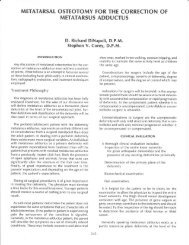Absorbable Screw Fixation - The Podiatry Institute
Absorbable Screw Fixation - The Podiatry Institute
Absorbable Screw Fixation - The Podiatry Institute
Create successful ePaper yourself
Turn your PDF publications into a flip-book with our unique Google optimized e-Paper software.
CHAPTER 11 59threaded, whereas the SR-PLLA screw is availablefully- or partially-threaded. Current criteria for theuse of BIOFIX screws include humeral head fractures,olecranon fractures, condylar fractures of thehumerus, condylar fractures of the distal femur orproximal tibia, displaced ankle fractures, and anklearthrodesis.5 <strong>The</strong>y have also been used successfullyin subtalar afihrodesis.<strong>The</strong> most significant difference between theSR-PGA and SR-PLLA screws is strength retention.<strong>The</strong> SR-PGA screw is stronger, but the SR-PLLAscrew persists longer.' <strong>The</strong> SR-PGA screw loses itsmechanical resistance in vivo between 30-60 days,and the SR-PLLA screw between 3-72 months.Biodegradation time, or time to complete absorption,is 5-10 months for the SR-PGA material, and variesfrom 15 to 60 months for SR-PLLA materiai. <strong>The</strong> actualtime depends on shape, size, molecular weight, andvariable tissue environments of implantation.<strong>The</strong> initial resistance to shear and flexion forcesof the screws is 20-30 times that of cancellousbone. <strong>The</strong>ir modulus of elasticity is comparableto cortical bone, and roughly 2-3 times that ofcancellous bone. By comparison, the modulus ofelasticity of stainless steel is rnore than 20 times thatof cancellous bone. Clinically, the decrease inbending strength is more rapid than that of shearstrength.3'5 <strong>The</strong> screws require a dedicated screwdriver, tap, and countersink. A11 instrumentationpieces are compatible with the standard AO/ASIFquick release handles (Fig. 1).<strong>Screw</strong> InsertionInsertion of the screws requires attention to technique,and the following specifics are recommended by themanufacturers. Reduction of the osseous componentsis achieved and stabilized with clamps.Specific to ankle fracture repair, the screw is inserled75-85 degrees to the fracture line, as opposed to 90degrees. If the reduction is exact, the direction offixation is not the same as the rotational axis of thefragment, since rotation is not possible without anew fracture or failure of fixation.' <strong>The</strong> drill and/orover-drill hole is made with the corresponding sizedrills. Tapping is performed with care to ensurecrossing the entire length of the hole. <strong>The</strong> near cortexis then countersunk. <strong>The</strong> screw channel isflushed with saline and the screw insefied. <strong>The</strong> headof the screw is then cut so that only 1 mm remainsabove the cofiex.Since the torsional strength of the absorbablescrew is not as high as that of a metallic implant,care must be taken when inserting the screw. <strong>The</strong>screw must turn easily into the bone, otherwise itmay break. If a screw breaks, the exposed portionof screw is cut flush with the bone, rather thanattempting to remove it. A few reasons for screwbreakage are suggested by the Finnish surgeons:the drill hole may not be long enough; the tappingmay have been done improperly; or the drill holemay have been dry. Lastly, the longer the screw,the more chance for increasing the friction forceson the screw. <strong>The</strong>refore, extra care should be takenduring insertion.5Figure 1. <strong>The</strong> tips of the screw driver, countersink, and tap requiredfor the BIOFIX absorbable screws. Note the size of the countersinkcompared to a standard AO/ASIF countersink.AdvantagesIn direct comparison with metallic screws, severalfeatures of absorbable screws are highlighted bythe manufacturers. <strong>Absorbable</strong> implants essentiallyeliminate the financial burden of secondary proceduresto remor,e internal fkation. This is oftenregarded as a psychological benefit as well, pafiicularlyin children. Magnetic resonance and computedtomography imaging are also possible without thescattering caused by metallic devices. <strong>The</strong> absorbablematerial is considered tissue equivalent. <strong>Absorbable</strong>screws may also be left in sites of infection as theyare bacteriostatic. Growing bacteria do not affect theabsorption of the screws. <strong>The</strong> relationship betweenthese screws and the presence of stress protection orstress shielding has akeady been discussed.

















